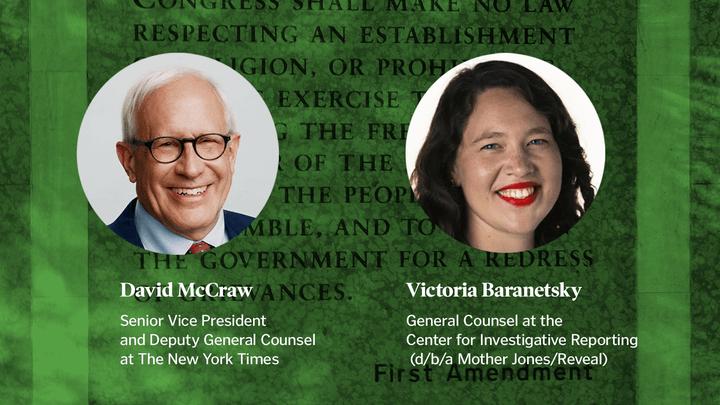On Monday, The Panama Papers — the giant collaborative investigation spearheaded by the International Consortium of Investigative Journalists — won the Pulitzer Prize for Explanatory Reporting.
The Panama Papers may be one of the world’s largest collaborative efforts between journalists at different news organizations, but it certainly isn’t the only one. Back in 2010, Democracy Fund’s Josh Stearns documented more than 30 existing collaborations from organizations ranging from local news affiliates working with each other to public and private partnerships, to newsrooms collaborating with universities.
Now collaboration (which can take many shapes) is big. Olivia Ma, of the Google News Lab, expanded upon Stearns’ list in her Nieman prediction last year, outlining several partnerships and collaborations between news organizations and technology companies and predicting that there will be more collaboration in 2017 “than any year to date.”
Related Training: Lessons From Pulitzer Winners
Collaboration has inspired journalism conferences, summits, Pew studies, J-Lab reports, essays and stories on newsrooms working together.
It been cited, among other things, as one of the driving forces that could help the news ecosystem.
It’s been seven years since Stearns published his comprehensive list, and I thought I would update it with several dozen collaborations and partnerships that have sprung up since then. Feel free to use this as a starting point. If you know of others, please add them to this Google Form, and we’ll update the post in a week. (This would also make an excellent database for newsrooms and funders and audiences to reference.)
International ICIJ Partnerships
All of the International Consortium of Investigative Journalist projects have involved journalists from multiple countries, and all of them have operated on the “simple operating principle [of] collaboration, collaboration, collaboration!”
- Panama Papers, the year-long collaboration between 370 journalists in 76 countries, which analyzed 11.5 million leaked records and exposed “offshore companies linked to more than 140 politicians in more than 50 countries.”
- Secrecy for Sale, which worked with more than 110 journalists in 58 countries to “strip away the biggest mystery associated with tax havens: the owners of anonymous companies.”
- Luxembourg Leaks, the 2014 investigation by ICIJ which exposed secret tax structures sought by global companies. It involved over 80 journalists in 26 countries.
- Swiss Leaks, in which journalists from 45 countries examined documents from confidential HSBC records.
- The World Bank’s Promise to the Poor examined how the World Bank does (or doesn’t) protect vulnerable populations.
Other International Partnerships
- Nine journalists set out to investigate the criminal migrant shipping network. The results were published in Belgium, France, Italy, Romania, Jordan and Turkey.
- The Khadija Project partnered reporters from several news organizations across Europe to report on corruption among Azerbaijan’s governing elite.
- An international team of journalists collaborated on a data journalism initiative looking into $4 billion of good in the EU confiscated from criminals by authorities.
Local Partnerships and Collaborations
- The Toronto Star and Miami’s El Nuevo Herald teamed up in 2013 to investigate sex trafficking between Canada and Cuba.
- The ANNthology newsletter compiles stories from 17 local sources of news and information in Ann Arbor, Michigan.
- The Miami Herald and The Tampa Bay Times share a statehouse bureau and coordinate coverage.
- Three nonprofit newsrooms in Illinois share content (and two of them operate under the same roof) reports Current. (This is in addition to another collaboration between Illinois Public Media and six other newsrooms in the state of Illinois.)
- Alaska Public Media in Anchorage, KTOO Public Media in Juneau and KUCB in Unalaska collaborate on energy issues.
- Seven public media stations in the Ohio River region work together to report on the economy and health of the multi-state area.
- Four public radio stations in Arkansas work together in a statewide news network. (There are also many other collaborations within public media newsrooms, including the New England News Collaborative, Natural State News in Arkansas, the Texas Station Collaborative, the Kentucky Center for Investigative Reporting, Upstate Insight and the 56 newsrooms which have worked on local journalism initiatives funded by the Corporation of Public Broadcasting which were launched in 2009 and 2010. Barriers to other collaborations are lower than pubcasters think, writes Torey Malatia in this 2014 Current essay.)
- California public media stations teamed up for 2016 election coverage.
- Stations in Dallas and New Orleans collaborated on a call-in show examining police shootings in the summer of 2016.
- KERA and The Dallas Morning News worked together to examine the stigma of mental illness.
- Baltimore public radio stations shared resources and coverage following the death of Freddie Gray in 2015.
- In 2010, the California HealthCare Foundation Center for Health Reporting teamed up with the Chico Enterprise-Record on a 29-story series on the health consequences of wood stove smoke pollution.
- In 2013, NBC Bay Area’s Investigative Unit teamed up with the Center of Investigative Reporting over nine months to report on a wave of foreclosures in the Bay Area.
- The same year, NBC Bay Area also worked with the Investigative Reporting Program at UC-Berkeley to examine the school’s ballooning athletic budget. (Investigative reporter Stephen Stock outlines how he approached working with these partners in this essay.)
- Mercer University partners with a local newspaper and a local public radio station to report on local news.
- The News Outlet of Ohio partners local public universities in Northeastern Ohio with media partners across the state.
- In 2015, WSB-TV and The Atlanta Journal Constitution worked together on Over the Line: Police Shootings in Georgia.
- Telemundo Chicago and NBC 5 Chicago teamed up to investigate police prosecutions.
- Reporters at the San Francisco Public Press collaborated with New America Media and El Tecolote in 2012 to report on human trafficking in the Bay Area.
- Coast Alaska unites the public radio stations in Southeastern Alaska.
- In the fall of 2016, “journalists, housing leaders and Portland residents [came together] with a common purpose: to create inclusive, informed public conversations that drive solutions to the Portland region’s housing crisis.”
- “A collaborative investigative reporting project on the local impacts of New Jersey’s toxic legacy,” from journalists in the NJ News Commons, NJTV News and NJ Spotlight.
- “See what happens when all of the storytellers in one region turn their attention to one topic, the St. Louis River.”
- The Detroit Journalism Cooperative contains five media outlets that report on the city’s future after bankruptcy.
- The SF Homeless Project featured over 70 media organizations blitzing the city to cover the causes and solutions to homelessness in the SF Bay area.
- NOLA.com, The Times-Picayune and Fox 8 reporters NOLA.com, The Times-Picayune and Fox 8 reporters investigated campaign finances in Louisiana during a four-month-long investigation in 2013.
- Heather Bryant profiles two organizations in Somerville, Massachusetts that teamed up to profile local community members in print, web and video.
- Small towns, big change, from the Solution Journalism Network in Taos, New Mexico, covers “the challenges facing rural communities — and [the] solutions.”
Partnerships between national and local organizations
- In 2017, NPR collaborated with seven stations to chronicle the lives of U.S. military troops. The year before, they collaborated with reporters at Ohio Valley ReSource to report on advanced black lung cases in Appalachia.
- ProPublica, a leader in collaborating with other newsrooms, worked with 12 media partners after the most recent Presidential election to launch Documenting Hate, a site that tracks reports of hate crimes in the United States.
- This followed ProPublica’s Electionland initiative, which partnered over 1,100 journalists, students and data analysts to collect reports of voting fraud of intimidation.
- ProPublica routinely collaborates with other newsrooms, including a collaboration with Frontline and the Times-Picayune of New Orleans on the New Orleans Police Department in the aftermath of Hurricane Katrina, collaboration with NPR on traumatic brain injuries suffered by soldiers, the Red Cross and vanishing worker protections, one with This American Life and the Sunlight Foundation on the financial crisis, one with the New York Daily News on police abuse, one with The Lens on sea levels in Louisiana and countless others which are listed on their awards page.
- Buzzfeed and the Seattle Times teamed up to investigate Warren Buffett’s pattern of charging minorities more for mobile homes.
- Rape on the Night Shift, a 2015 collaboration between several news organizations including Reveal, KQED, Univision and the Investigative Reporting Program, explored sexual violence against janitors on the job.
- In 2015, NPR and Colorado Public Radio teamed up to investigate how soldiers with mental health disorders were dismissed for “misconduct.”
- In 2016, The Marshall Project and NPR worked together to investigate prisoners who were placed in solitary confinement and then given a roommate.
- Several journalism organizations collaborate together on ClimateDesk, which explores the changing climate.
- The Weather Channel worked with Telemundo and The Investigative Fund to tell the story of two brothers who tried to cross Death Valley.
- USA Today along with the national Gannett network reported on fugitives across state lines.
- NYU’s Journalism School and The New York Times work together on a hyperlocal site looking at the East Village.
- WNYC, NJ Spotlight and Bloomberg Businessweek collaborated on a five-part series on a new retail and entertainment complex in the Meadowlands.
Collaboration and sharing between journalists, as well as with their audiences and other organizations
- In 2017, over 3,000 journalists joined a Slack channel for reporters to work together on filing FOIA requests and covering President Trump’s administration. The channel collaborativenews.slack.com, run by Heather Bryant, helps journalists collaborate with each other.
- The Slack channel Digital Journalism Rocks contains hundreds of journalists who share tools and best practices. (Other Slack communities for journalists are listed here.)
- ProPublica invites audience members to sign up for updates and actions through their Get Involved initiative.
- WBEZ’s Curious City (and Hearken) virtually invite audiences into newsrooms to ask questions they’d like investigated.
- The Huffington Post launched OffTheBus, a home for citizen journalism, during the 2012 election cycle.
- The New York Times worked with documents provided by the American Civil Liberties Union in 2012 to investigate cellphone tracking by police officials.
- USC’s Annenberg School of Journalism worked with the Engineering School to report on congestion, road accidents and public transportation in Los Angeles between 2012-2016.






